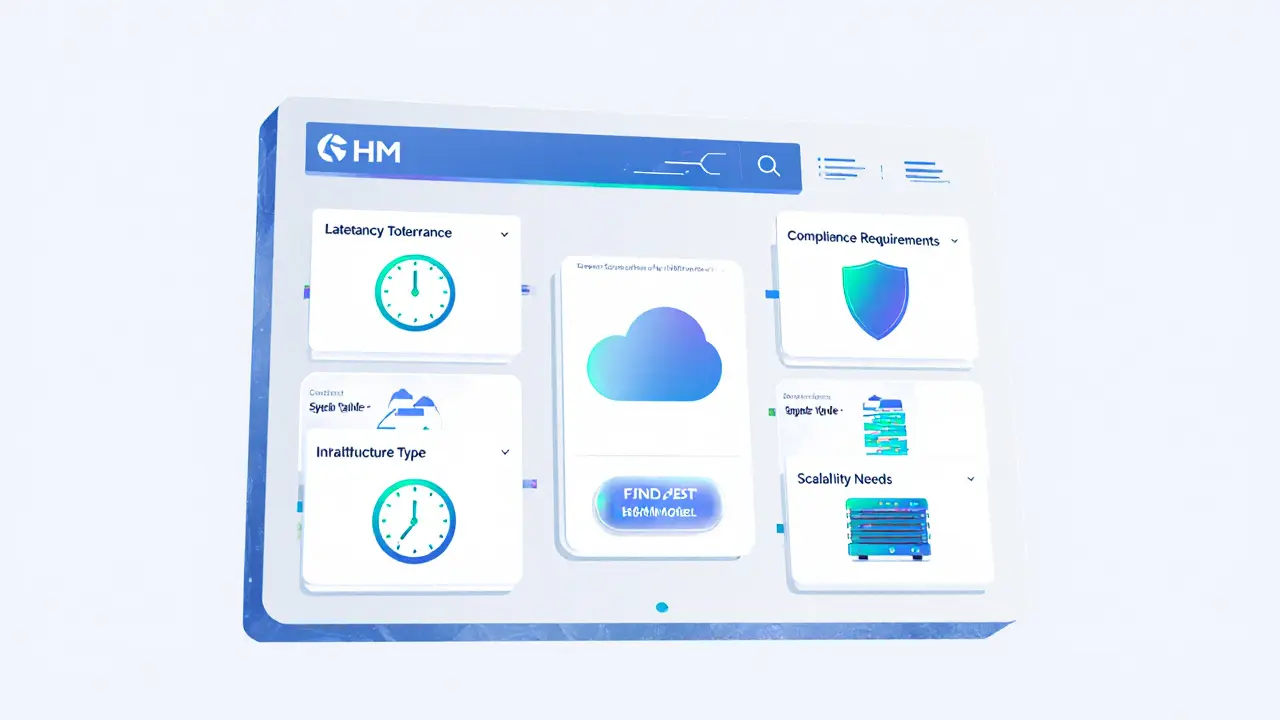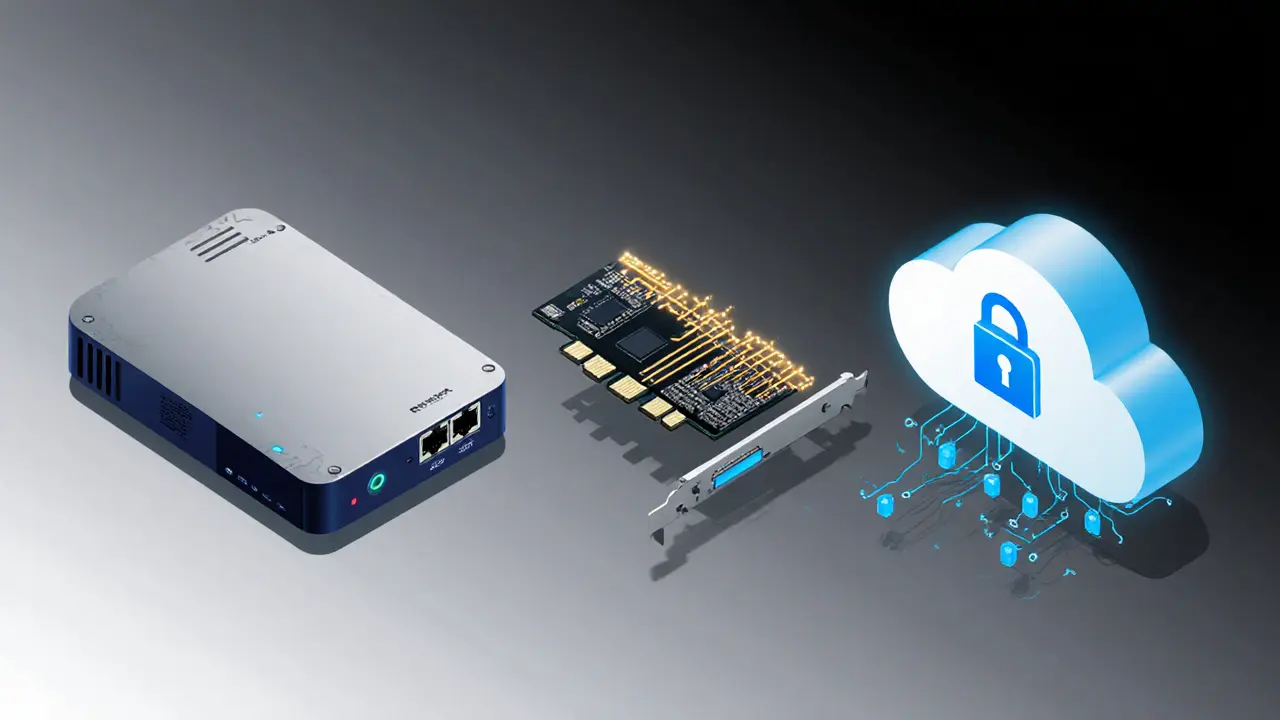May 15, 2025, Posted by: Ronan Caverly

Institutional HSM Deployment Selector
Use this tool to determine which HSM deployment model best suits your enterprise needs based on key factors like latency tolerance, compliance requirements, and infrastructure constraints.
Network-Attached Appliance
Centralized key management across multiple servers with ~1-2ms latency.
FIPS 140-2, PCI, CCPCIe Card
Low-latency, high-performance solution integrated directly into servers.
FIPS 140-2, PCICloud-Hosted Service
Managed service with flexible scaling and reduced operational overhead.
FIPS 140-2, PCI, CCInstitutional grade HSM solutions are the go‑to choice when an organization can’t afford a single cryptographic slip‑up. Below you’ll see what makes these devices different, how to pick the right model, and what to watch out for during rollout.
Quick Takeaways
- Institutional HSMs keep keys inside tamper‑proof hardware and meet certifications like FIPS 140‑2 Level3.
- Three common deployment styles exist: network‑attached appliances, PCIe cards, and cloud‑hosted HSM services.
- Key selection criteria include latency, compliance, integration effort, and scalability.
- Implementation success hinges on clear key‑lifecycle policies and API compatibility (PKCS#11, KMIP, REST).
- Future‑proofing means watching for quantum‑resistant algorithms and deeper DevOps integration.
What Is an Institutional Grade HSM?
When enterprises need iron‑clad cryptographic protection, Institutional Grade Hardware Security Module (HSM) is a tamper‑resistant appliance that generates, stores, and uses cryptographic keys inside certified hardware. Unlike software‑only key stores, an HSM isolates keys from the host operating system, making it virtually impossible for malware or insider attacks to extract them. Modern units embed a secure operating system, a True Random Number Generator (TRNG) for entropy, and multiple layers of physical hardening such as epoxy encapsulation and mesh detection.
Core Security Certifications
Certificates act as a quick health‑check for any institutional HSM. The three most widely recognized standards are:
- FIPS 140‑2 Level 3 - U.S. government validation that demands hardware tamper detection, identity authentication, and approved cryptographic algorithms.
- Common Criteria EAL4+ - International evaluation that rates security functionality and assurance levels.
- PCI HSM - Specific to payment‑card environments, confirming the device meets PCI DSS key‑management requirements.
When a vendor claims compliance, always request the latest validation report; standards are periodically revised and older certificates may no longer cover newer attack vectors.

Deployment Models at a Glance
Choosing between on‑premises, PCIe, and cloud options depends on latency tolerance, existing infrastructure, and regulatory constraints. The table below outlines the trade‑offs.
| Model | Typical Latency | Physical Footprint | Key Management Scope | Compliance Fit | Best For |
|---|---|---|---|---|---|
| Network‑attached appliance | ~1‑2ms (LAN) | 1‑U rack unit | Centralized across multiple servers | FIPS140‑2, PCI, CC | Large enterprises needing multi‑site key sharing |
| PCIe card | <1ms (direct bus) | PCIe slot in host server | Server‑local, extremely fast | FIPS140‑2 Level3, PCI | High‑frequency trading, low‑latency DB encryption |
| Cloud HSM (service) | 2‑5ms (cloud network) | None (managed service) | Global, API‑driven, multi‑region | FIPS140‑2 Level3, PCI, GDPR‑ready | Hybrid workloads, DevOps pipelines, rapid scaling |
How to Pick the Right Solution
Follow this decision flow to narrow the field:
- Identify regulatory drivers. If PCI DSS or government contracts are in play, prioritize FIPS140‑2 Level3 and Common Criteria certification.
- Measure latency sensitivity. Transaction‑heavy environments (e.g., stock exchanges) usually need PCIe cards; most back‑office applications can tolerate network‑attached or cloud latency.
- Audit existing infrastructure. Do you already have a secure data‑center rack? If yes, a network appliance fits. If your workloads live in AWS, Azure, or GCP, a cloud HSM reduces integration friction.
- Plan for growth. Cloud HSMs shine for elastic scaling; on‑premises boxes require capacity planning and periodic hardware refresh.
- Check API compatibility. Most HSMs expose PKCS#11, but newer services also support KMIP and REST. Choose the model that aligns with your development stack.
In practice, many large banks run a hybrid mix: PCIe cards for ultra‑low‑latency payment processing, network‑attached appliances for internal PKI, and cloud HSMs for development and testing environments.
Implementation Best Practices
Deploying an institutional HSM is a multi‑phase effort. Skipping any step can erode the security gains.
- Define the key lifecycle up front. Map out creation, activation, rotation, backup, and eventual destruction. Use the HSM’s built‑in key‑versioning to enforce rotation policies.
- Leverage the built‑in TRNG. Never seed keys from external sources; let the HSM’s entropy source handle it.
- Isolate management traffic. Place the HSM in a dedicated VLAN or security group and enforce mutual TLS for API calls.
- Integrate with existing IAM. Bind HSM access controls to your directory service (Active Directory, LDAP, or cloud IAM) to simplify role‑based permissions.
- Test tamper response. Simulate a physical breach (e.g., disconnect power) to confirm the device zeroes keys as expected.
- Document backup procedures. For on‑premises hardware, maintain an offline, encrypted backup of key blobs under controlled access; cloud HSMs typically provide automatic regional replication.
Future Outlook
The HSM market is moving toward cloud‑native, DevOps‑ready services. Expect these trends in the next 2‑3 years:
- API‑first design. RESTful and gRPC interfaces will become standard, reducing reliance on legacy PKCS#11.
- Integration with secret‑management platforms (e.g., HashiCorp Vault) for unified credential handling.
- Support for quantum‑resistant algorithms such as CRYSTALS‑KD and NTRU, often offered as optional firmware updates.
- Greater observability - built‑in metrics and logging that feed directly into SIEM and SOC workflows.
Organizations that adopt these capabilities early will keep their cryptographic backbone agile enough to meet both current compliance pressure and tomorrow’s threat landscape.

Frequently Asked Questions
Do I really need an HSM if I already use encrypted disks?
Encrypted disks protect data at rest, but the encryption keys themselves are still stored in the host OS and can be extracted by malware. An HSM isolates those keys in hardened hardware, eliminating that attack surface.
Can I run a cloud HSM in a highly regulated industry like banking?
Yes, provided the service is FIPS140‑2 Level3 certified and the provider offers data‑residency options that meet regulator requirements. Many banks use a hybrid model to keep the most sensitive keys on‑premises while leveraging cloud HSM for less‑critical workloads.
What’s the performance difference between PCIe and network‑attached HSMs?
PCIe cards operate directly on the server bus, typically delivering sub‑microsecond latency for signing and decryption. Network appliances add network stack overhead, usually landing around 1‑2ms on a fast LAN, which is still acceptable for most batch or API‑driven services.
How often should I rotate keys stored in an HSM?
Rotation policies depend on regulatory mandates and risk appetite. A common practice is every 12‑24months for master keys, with session keys rotated per transaction or hourly for high‑throughput services.
Is there a way to audit all operations performed by the HSM?
All reputable HSMs generate signed audit logs that capture key creation, usage, and deletion events. These logs can be streamed to a SIEM for real‑time monitoring and forensic analysis.
Write a comment
Comments
Navneet kaur
Security isn’t just a tech thing, it’s a moral duty. If you ignore HSM best practices, you’re basically inviting theft.
May 15, 2025 AT 09:35
Marketta Hawkins
Look, the US should be leading in crypto‑hardware, not copying overseas models 😂. The guide even forgets the good old American standards.
May 18, 2025 AT 06:19
Drizzy Drake
I totally get that enterprise security can feel overwhelming, especially when you’re juggling compliance and performance.
What this guide does well is break down the decision space into latency, compliance, and infrastructure categories.
By mapping each business requirement to a specific HSM model, you avoid the common pitfall of buying the flashiest hardware without a real need.
The latency section reminds us that sub‑millisecond response times are only critical for certain high‑frequency applications.
For most workloads, a 1‑2 ms window is perfectly acceptable and gives you more flexibility in vendor selection.
Compliance‑wise, the tiered approach – from standard FIPS 140‑2 to strict government‑level certifications – helps organizations align with audit requirements.
I also like the reminder to verify certification reports, because a paper certification can be misleading if the underlying firmware isn’t up to date.
The infrastructure options cover on‑prem, hybrid, and cloud‑only deployments, which is essential given the shift toward multi‑cloud strategies.
When you read the scalability matrix, think about not just current load but future growth; a single‑server PCIe card may become a bottleneck.
Conversely, the network‑attached appliance shines in large‑scale environments where centralised key management reduces operational overhead.
Don’t forget about API compatibility; PKCS#11, KMIP, and REST interfaces each have their own quirks and ecosystem support.
If you’re already using a particular key management service, choosing an HSM that speaks the same language saves integration headaches.
The guide’s structure also encourages a checklist mindset, which is great for audit trails and internal approvals.
In practice, I’ve seen teams skip the latency analysis and later regret the performance impact on transaction processing.
Overall, treating the selection as a data‑driven exercise rather than a gut feeling leads to better security ROI.
So, take the time to fill out the selector, compare the models, and you’ll end up with an HSM that actually fits your enterprise.
May 21, 2025 AT 03:02
AJAY KUMAR
This guide is a disaster for any serious enterprise.
May 23, 2025 AT 23:46
bob newman
Oh sure, just pick a cloud HSM and hope the vendor doesn’t secretly hand your keys to the CIA. The “flexible scaling” line is pure marketing fluff.
May 26, 2025 AT 20:29
Anil Paudyal
Looks okay but check the latency numbers before buying.
May 29, 2025 AT 17:13
Kimberly Gilliam
Pretty much the same as every other HSM brochure
June 1, 2025 AT 13:57
Jeannie Conforti
Great rundown! It really helps to see the latency and compliance side by side so you can match it to your business needs.
June 4, 2025 AT 10:40
tim nelson
Take note of FIPS 140‑2 levels when you compare models.
June 7, 2025 AT 07:24
Zack Mast
In the grand scheme, a hardware module is just a physical manifestation of trust; the guide reminds us that trust must be measured, not assumed.
June 10, 2025 AT 04:08
Dale Breithaupt
Nice summary-pick the model that fits your scale, and you’ll avoid a lot of headaches later.
June 13, 2025 AT 00:51
Rasean Bryant
Looks solid, just remember to audit the vendor regularly.
June 15, 2025 AT 21:35
Angie Food
Honestly, these charts are over‑engineered and won’t help most mid‑size firms.
June 18, 2025 AT 18:19
Jonathan Tsilimos
While the taxonomy of deployment paradigms is comprehensive, a deeper exposition on TPM integration would enhance the utility for security architects.
June 21, 2025 AT 15:02
jeffrey najar
The API compatibility note is spot on-make sure your PKCS#11 library is up to date before integration.
June 24, 2025 AT 11:46
Rochelle Gamauf
One must appreciate the meticulous categorisation, yet the omission of post‑quantum considerations betrays a certain complacency.
June 27, 2025 AT 08:29
Jerry Cassandro
Is there any guidance on key rotation frequency for the network‑attached appliance?
June 30, 2025 AT 05:13
Parker DeWitt
All these options are nice, but if you ask me, the PCIe card is the only real solution 🚀.
July 3, 2025 AT 01:57
Allie Smith
Choosing an HSM is like choosing a partner; you need trust, compatibility, and a shared vision for the future.
July 5, 2025 AT 22:40
Lexie Ludens
Another generic list that pretends to solve every security nightmare.
July 8, 2025 AT 19:24
Aaron Casey
From a cryptographic lifecycle perspective, the latency thresholds directly impact HSM selection for high‑frequency trading workloads.
July 11, 2025 AT 16:08
Leah Whitney
Make sure the solution supports your compliance audits.
July 14, 2025 AT 12:51
Lisa Stark
While the guide may feel dense, its systematic approach actually saves time when you have to justify HSM choices to auditors.

Author
Ronan Caverly
I'm a blockchain analyst and market strategist bridging crypto and equities. I research protocols, decode tokenomics, and track exchange flows to spot risk and opportunity. I invest privately and advise fintech teams on go-to-market and compliance-aware growth. I also publish weekly insights to help retail and funds navigate digital asset cycles.